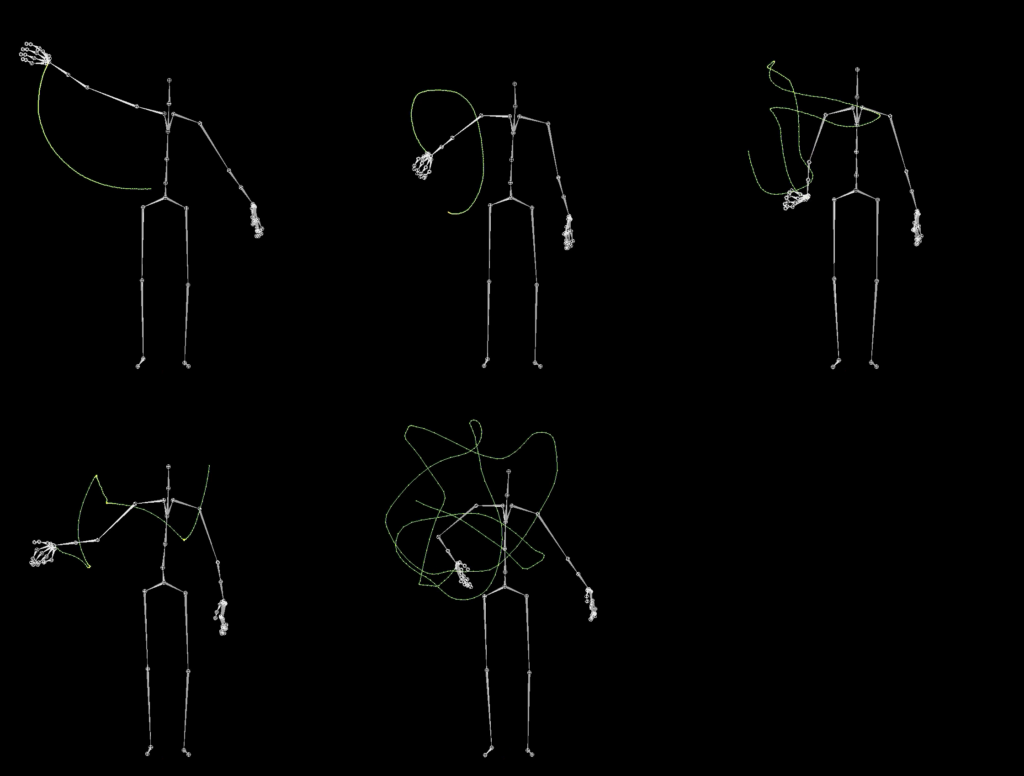In contemporary dance, qualitative aspects of body movement play an important
role. These aspects foreground the communicative, stylistic and expressive potential
of movement.
Common Movement Qualities
Up to now, there exists no commonly accepted taxonomy for characterising and
classifying movement qualities in dance.
Laban Movement Analysis
Nevertheless, the structural notation Laban Movement Analysis (LMA) introduced by Rudolf Laban has gained prominence. Central to LMA are four categories that formalise different aspects of the human body: Body, Space, Shape, and Effort.
Of particular interest with regards to movement qualities is the Effort category. This category describes aspects that relate to the dynamics, energy, and inner intention of movement, all of which contribute to the expressivity of movement. This category is subdivided into four Effort Factors (EF): Space, Weight, Time, Flow. Each Factor possesses two opposing dimensions. The Space factor describes the directedness of movement which can either be Direct or Indirect. The Weight factor describes the strength of movement which can either be Light or Strong. The Time factor describes the urgency of movement which can either be Sustained or Sudden. The Flow factor describes the continuity of movement which can either be Free or Bound.
Movement Dynamics
Several researchers and dance practitioners characterise movement qualities
in terms of relationships between forces and dynamics. According to this principle,
the dynamics of movement results from the interaction between force and time. Related to this principle is the concept of flowing energies whose initiation, sustenance, and termination gives rise to the articulated attributes of movement. The following six dynamic qualities are differentiated:
- Sustained = slow, smooth, continuous, even
- Percussive = sudden, sharp, choppy, jagged
- Swinging = sway, to and from, pendulum, undercurve
- Suspended = stillness, balance, high point
- Collapsed = fall, release, relax
- Vibratory = shake, tremble, wiggle
Idiosyncratic Movement Qualities
Many choreographers in contemporary dance develop their own system of
movement qualities alongside terminology to characterise them. Some choreographers have taken the initiative to disseminate their use of movement qualities to a wider audience.
EC | PC
Since 2005, choreographer Emio Greco and director Pieter C. Scholten have
participated in several interdisciplinary research projects that document the
communicative processes employed in their dance company EC | PC. A particular
focus was placed on the oral instructions given to the dancers. These
instructions emphasise the conceptual aspects of movement and avoid prescriptive
proposals to not limit the dancer’s own inspiration. There are three different
types of movement qualities that the instructions relate to. Some instructions
are used to invoke imagery relating to the sensation of movement, other instructions
deal with the intentional aspect of movement, and again other instructions
convey the meaning of the action that is involved in the movement. These movement qualities form part of a set of techniques that are taught to professional dancers in workshops entitled Double Skin / Double Mind.
Studio Wayne McGregor
A specific emphasis on the relationship between mental imagery and movement
qualities has emerged from a collaboration between choreographer Wayne
McGregor and cognitive scientist Philip Barnard. McGregor involves his
dancers in the creation of new movement material by giving them tasks in the
form of verbal or written instructions. This approach was refined by relating the
tasks to mental imagery which dancers can explore through mental manipulation
techniques. Following this approach, dancers draw from their mental landscape
and ideate movements that are guided by their perceived and imagined surroundings. The movement qualities that result from this approach are related to
mental attributes rather than direct attributes of the movements themselves. The manipulation techniques for mental imagery are disseminated among professional dancers in the form a system named “Choreographic Thinking Tools”.
Instituto Stocos
During the E2-Create project, a particular focus has been placed on studying the choreographic techniques employed by Muriel Romero, a professional dancer and choreographer at the Madrid-based dance company Instituto Stocos.
Over the course of her career as professional dancer and choreographer, Muriel Romero has developed a creative process that heavily relies on employing
movement qualities as choreographic building blocks. These movement
qualities are organised hierarchically. At the lowest level, movements qualities
are elementary in the sense that they expose their expressive characteristics
within a single domain. At higher levels, more complicated movement qualities
can be constructed by combining or juxtaposing lower level movement qualities.
The domains of elementary movement qualities are: Dynamics, Time, Space, and
Shape.
- Dynamics deals with the temporal evolution of movement, focusing on
changes in velocity and directionality. - Time deals with the long term temporal structure of movement or the absence of movement.
- Space deals with how movement traverses space or places poses within space.
- Shape deals with the transformation of movements or poses while preserving some of their recognisability.
Some of these movement qualities were studied in more depth through video recordings and motion capture. This includes the following five elementary movement qualities.
- Space – Levitation: Body parts are pulled towards a target position within the
dancer’s reach space. - Dynamics – Fluidity: Body parts move smoothly without
taking sharp turns or suddenly changing velocity. - Dynamics – Particles: Body parts float weightlessly while frequently and erratically changing direction.
- Dynamics – Staccato: Body parts move along straight lines and quickly speed up
and slow down at the beginning and ending of a line. - Dynamics – Thrusting: Body parts propel themselves outwards and rebound afterwards.

This study of movement qualities has informed the development of a simulation-based generative system that employs non-anthropomorphic articulated bodies that exhibit expressive movements based on the same movement qualities. This system has been applied in a dance piece entitled “Embodied Machine”. More information about the system and its role in the creative process that led to the dance piece is available here.